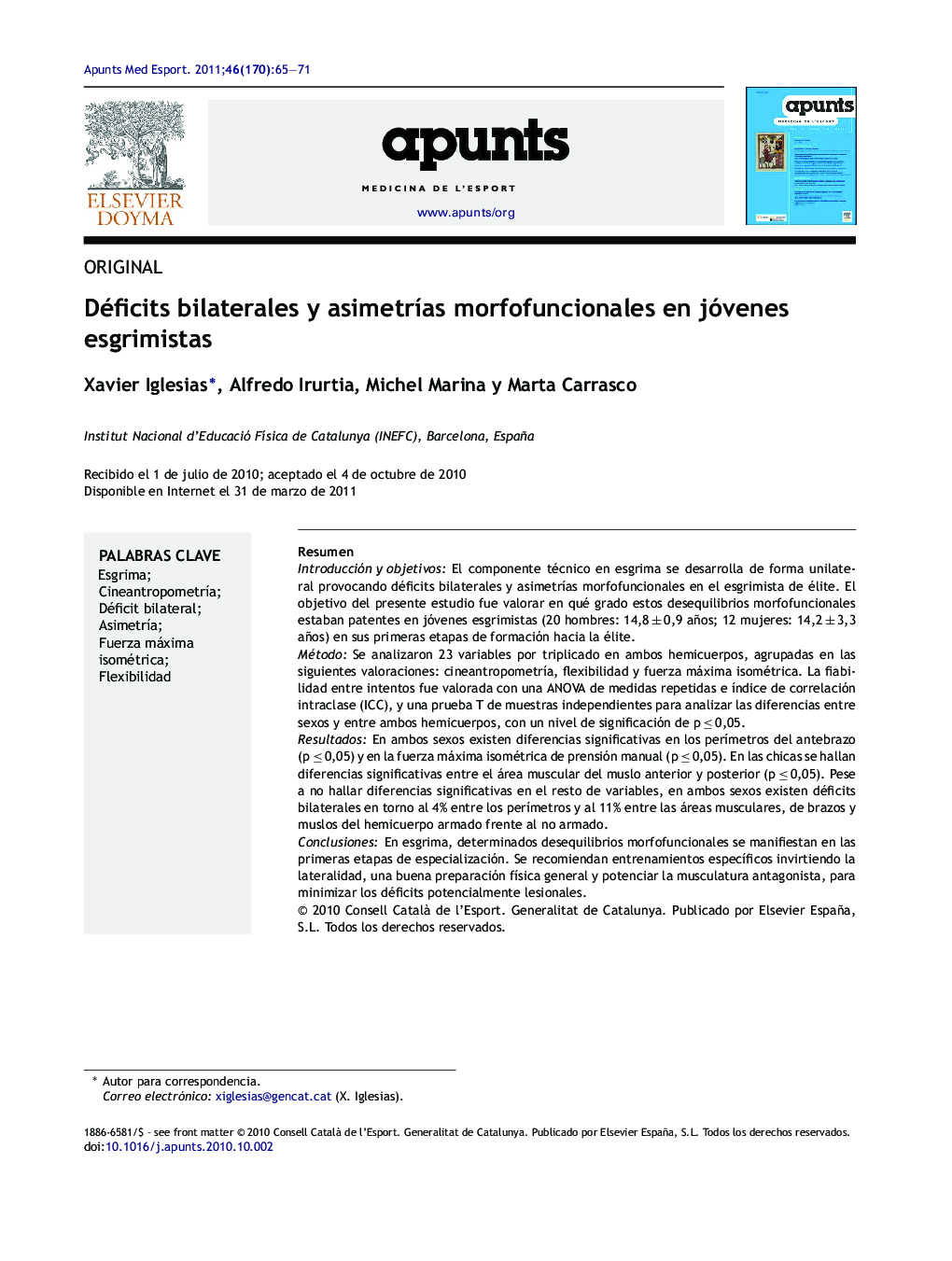| کد مقاله | کد نشریه | سال انتشار | مقاله انگلیسی | نسخه تمام متن |
|---|---|---|---|---|
| 2738793 | 1148253 | 2011 | 7 صفحه PDF | دانلود رایگان |

ResumenIntroducción y objetivosEl componente técnico en esgrima se desarrolla de forma unilateral provocando déficits bilaterales y asimetrías morfofuncionales en el esgrimista de élite. El objetivo del presente estudio fue valorar en qué grado estos desequilibrios morfofuncionales estaban patentes en jóvenes esgrimistas (20 hombres: 14,8 ± 0,9 años; 12 mujeres: 14,2 ± 3,3 años) en sus primeras etapas de formación hacia la élite.MétodoSe analizaron 23 variables por triplicado en ambos hemicuerpos, agrupadas en las siguientes valoraciones: cineantropometría, flexibilidad y fuerza máxima isométrica. La fiabilidad entre intentos fue valorada con una ANOVA de medidas repetidas e índice de correlación intraclase (ICC), y una prueba T de muestras independientes para analizar las diferencias entre sexos y entre ambos hemicuerpos, con un nivel de significación de p ≤ 0,05.ResultadosEn ambos sexos existen diferencias significativas en los perímetros del antebrazo (p ≤ 0,05) y en la fuerza máxima isométrica de prensión manual (p ≤ 0,05). En las chicas se hallan diferencias significativas entre el área muscular del muslo anterior y posterior (p ≤ 0,05). Pese a no hallar diferencias significativas en el resto de variables, en ambos sexos existen déficits bilaterales en torno al 4% entre los perímetros y al 11% entre las áreas musculares, de brazos y muslos del hemicuerpo armado frente al no armado.ConclusionesEn esgrima, determinados desequilibrios morfofuncionales se manifiestan en las primeras etapas de especialización. Se recomiendan entrenamientos específicos invirtiendo la lateralidad, una buena preparación física general y potenciar la musculatura antagonista, para minimizar los déficits potencialmente lesionales.
Introduction and aimsThe technical component in fencing is developed of unilateral form causing bilateral deficits and morphofunctional asymmetries in elite fencers. The aim of the present study was to assess the degree of these morphofunctional imbalances were significances in young fencers (20 men: 14.8 ± 0.9 years; 12 women: 14.2 ± 3.3 years) in their first stages of training towards the sport elite.MethodTwenty three variables in triplicate were analysed in both sides of the body and grouped in the following assessments: kinanthropometry; flexibility; isometric maximum strength. ANOVA with Tukey's post-hoc and intraclass correlation coefficient was used in order to determinate the reliability between trials. An independent samples t-test was used to analyse the differences between sexes and between both sides of the body. The significance level was established at P≤.05.ResultsIn both sexes, significant differences between perimeters of the forearm (P≤.05), and isometric maximum strength of fingers (P≤.05) was established. In addition, in girls there were significant differences between the muscular area of the anterior and posterior thigh (P≤.05). No significance differences were found in the other variables.ConclusionsIn fencing, some morphofunctional asymmetries are developed in the first stages of the sport specialisation. To minimise the potentially injuring deficits, we recommend strengthening the antagonist musculature with specific training sessions reversing the laterality and improving the physical conditioning.
Journal: Apunts. Medicina de l'Esport - Volume 46, Issue 170, April–June 2011, Pages 65–71